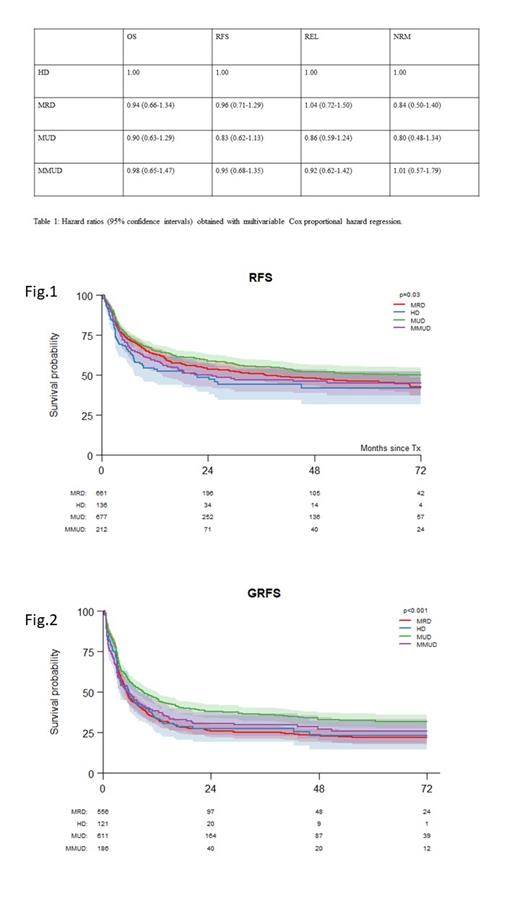Abstract
Introduction: The role of allogeneic hematopoietic cell transplantation (allo-HCT) in Philadelphia-positive chronic myeloid leukemia (Ph+ CML) changed profoundly after the introduction of tyrosine kinase inhibitors (TKIs). Nevertheless, allo-HCT still represents the preferred treatment option for selected high-risk patients in Europe, with TKI resistance as the most common indication in first chronic phase (CP1). Reported survival outcomes for patients transplanted in CP1 with matched related (MRD), matched unrelated (MUD) and mismatched unrelated donors (MMUD) are generally good, but there are no published data on transplants from haploidentical donors (HD). In this retrospective study, we aimed to compare HD outcomes with those using MRD/MUD/MMUD.
Patients and Methods: Patients who had received a first allo-HCT for Ph+ CML between 2012 and 2019 were selected from the EBMT database. Following the exclusion of patients transplanted using MRD, MUD, or MMUD and who received post-Cy GvHD prophylaxis, 1686 patients were included in the analysis. The impact of donor type on overall survival (OS) and relapse-free survival (RFS) was assessed using the Kaplan-Meier method; the cumulative incidence of relapse (REL) and non-relapse mortality (NRM) were estimated as competing events. Univariate comparisons were tested by log-rank or Gray's test, as appropriate. Cox proportional hazard models were applied to compare the risk of OS, RFS, REL and NRM in patients transplanted from MRD, MUD, MMUD and HD, adjusted for baseline disease and transplant characteristics, and to analyze the cause-specific hazard of NRM and REL. Two-sided p values of p<0.05 were considered statistically significant.
Results: Overall, the median age at transplant was 46 years (range 18-74). 62% were male. The median interval from diagnosis to transplant was 17.5 months. Disease status at transplant was CP1 in 43%, CP2 or later in 27%, accelerated phase (AP) in 12%, and blast phase (BP) in 18%. Karnofsky Performance Status (KPS) was ≥90 in 78% of patients. Donor was MRD in 661 patients (39.2%), MUD in 677 (40.2%), MMUD in 212 (12.6%) and HD in 136 (8%). The stem cell source was peripheral blood (PB) in 84% (52% in HD, p<0.001). Reduced intensity conditioning (RIC) was used in 33%. Median time to neutrophil engraftment was 18 days in HD, and 16 days in MRD/MUD/MMUD transplants. Median time to platelet (>20 x 10 9/L) engraftment was 25 days in HD, 14 days in MRD/ MUD and 15 days in MMUD transplants. 53% of patients were serologically CMV positive pre-transplant.
The cumulative incidence of grade II-IV acute GvHD at Day +100 was 25%, 27%, 31% and 39% in HD, MRD, MUD and MMUD, respectively (p=0.008). Chronic GvHD at +60 months was observed in 36%, 49%, 40% and 48% in HD, MRD, MUD and MMUD transplants (p=0.006), respectively. With regard to transplant outcomes at 60 months in HD, MRD, MUD and MMUD, OS was 51%, 51%, 62% and 58% (p=0.22), RFS was 42%, 46%, 51% and 45% (p=0.03, Fig.1), REL was 37%, 35%, 28% and 31% (p=0.064), NRM was 21%, 20%, 21% and 24% (p=0.34), and GVHD-free/relapse-free survival (GRFS) was 23%, 22%, 32% and 26% (p<0.001, Fig.2), respectively. By multivariable analyses (1,482 patients included), poorer OS was associated with older age (HR per 10 year increase 1.12, 95% CI 1.03-1.21, p=0.008), KPS <90 (HR vs ≥90 1.83, 1.51-2.23, p<0.0001), CMV+ status (HR 1.27 1.04-1.55, p=0.02), more advanced disease vs CP1 (p<0.0001); shorter RFS associated with KPS <90 (HR vs ≥90 1.51 1.27-1.80, p<0.0001), RIC (HR vs MAC 1.25, 1.05-1.50, p=0.01), disease status at transplant other than CP1 (overall p<0.0001), and BP vs AP (HR 1.33, 1.01-1.75, p=0.04); higher REL was predicted by KPS <90 (HR 1.54, 1.23-1.93, p<0.0001), RIC (HR vs MAC 1.31, 1.04-1.64, p=0.02) and disease status at transplant ≥CP2 vs CP1 and BP vs AP (p<0.0001); higher NRM was associated with older age (HR per 10 year increase 1.17, 1.05-1.31, p<0.005), KPS <90 (HR 1.47, 1.10-1.96, p<0.001), and PB as stem cell source (HR 1.61, 1.04-2.50, P=0.03). Table 1 shows the hazard ratio of OS, RFS, REL and NRM after transplants in MRD, MUD and MMUD compared to HD.
Conclusions: Apart from confirming the stage of disease at transplant as being a major prognostic factor, this study identified a trend to better RFS and GRFS in patients with Ph+ CML transplanted using MUD when compared to MRD/HD/MMUD. These results should be interpreted with caution given the limited number of patients who had HD.
Byrne: Incyte: Honoraria. Apperley: Bristol Myers Squibb, Novartis: Honoraria, Speakers Bureau; Incyte, Pfizer: Honoraria, Research Funding, Speakers Bureau. Craddock: Novartis Pharmaceuticals: Other: Advisory Board ; Celgene/BMS: Membership on an entity's Board of Directors or advisory committees, Research Funding. Ganser: Novartis: Honoraria; Celgene: Honoraria; Jazz Pharmaceuticals: Honoraria. Hayden: Amgen: Honoraria; Jansen, Takeda: Other: Travel, Accomodation, Expenses. Chalandon: Incyte, BMS, Pfizer, Abbie, MSD, Roche, Novartis, Amgen: Other: Advisory Board; Incyte: Speakers Bureau; Incyte, BMS, Pfizer, Abbie, MSD, Roche, Novartis, Gilead, Amgen, Jazz, Astra Zenec: Other: Travel EXpenses, Accomodation. Yakoub-Agha: Jazz Pharmaceuticals: Honoraria.


